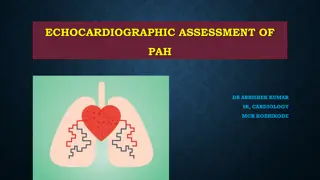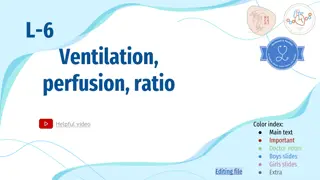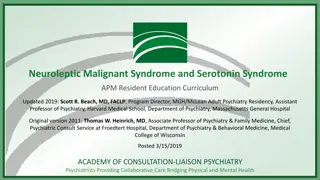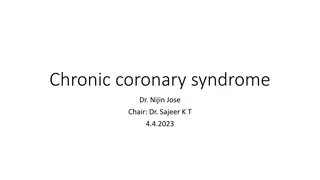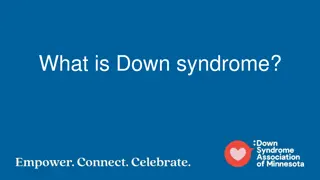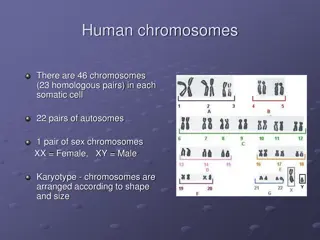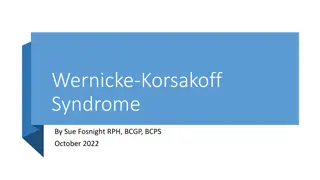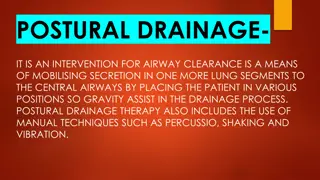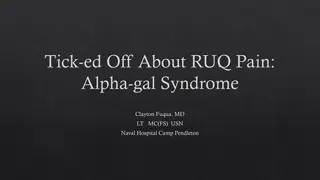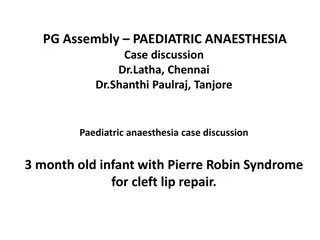Understanding Hantavirus Pulmonary Syndrome: Diagnosis and Clinical Review
This content provides an in-depth overview of Hantavirus Pulmonary Syndrome, including its clinical presentation, diagnosis, and management. It covers key points such as incubation periods, symptoms, and diagnostic tests like ELISA. The information emphasizes the need for a high index of suspicion due to the rarity and similarity of symptoms to other illnesses.
Download Presentation

Please find below an Image/Link to download the presentation.
The content on the website is provided AS IS for your information and personal use only. It may not be sold, licensed, or shared on other websites without obtaining consent from the author. Download presentation by click this link. If you encounter any issues during the download, it is possible that the publisher has removed the file from their server.
E N D
Presentation Transcript
The 5 The 5- -point Screen for Hantavirus point Screen for Hantavirus Hantavirus Conference 2019 Dine College, Tsaile Campus Aaron Kofman, MD CDC, Atlanta GA EIS Officer, Viral Special Pathogens Branch
Overview Clinical review of hantavirus disease Background on 5-point screen for hantavirus Use of 5-point screen in the Four Corners region Questions Overview
Clinical Review of Hantavirus Disease Clinical Review of Hantavirus Disease
Hantavirus Pulmonary Syndrome Incubation Period: Febrile Cardiopulmonary Stage: symptoms Roughly 30-40% of patients will die Diuretic Stage: Convalescence: Hantavirus Pulmonary Syndrome Incubation Period: 1-8 weeks Febrile Prodrome Cardiopulmonary Stage: 1-2 days of worsening respiratory Prodrome: : 3-6 days of flu-like illness Diuretic Stage: 3-7 days; polyuria Convalescence: may have residual fatigue, poor exercise tolerance
How do we diagnose someone with Hantavirus Pulmonary Syndrome? It is rare; even in the Four Corners region! Many people with rodent exposure most do not end up with hantavirus. Most clinicians have never seen a case It looks like other illnesses Influenza, pneumonia, etc. Most cases in spring/summer but can occur any time of year Bottom line: Requires a high index of suspicion in the appropriate context. How do we diagnose someone with Hantavirus Pulmonary Syndrome? It is rare; even in the Four Corners region! It looks like other illnesses Bottom line: Requires a high index of suspicion in the appropriate context.
Once we suspect ithow do we diagnose? Diagnostic tests ELISA for anti-hantavirus IgM and IgG antibodies Problem: turnaround time 4-6 hours to run the test But longer to ship the specimen Meanwhile, clock is ticking patient may be getting more ill Once we suspect it how do we diagnose? Diagnostic tests
Once we suspect ithow do we diagnose? Diagnostic tests ELISA for anti-hantavirus IgM and IgG antibodies Problem: turnaround time 4-6 hours to run the test But longer to ship the specimen Meanwhile, clock is ticking patient may be getting more ill What can make a difference? 1. Rapid referral to facilities with high-level intensive medical support and extracorporeal membrane oxygenation (ECMO) 2. Early identification of illness to enable #1 Once we suspect it how do we diagnose? Diagnostic tests What can make a difference? extracorporeal membrane oxygenation (ECMO)
Treatment for patients with Hantavirus Pulmonary Syndrome Supportive therapy Blood pressure medications Supplemental oxygen Extracorporeal membrane oxygenation = ECMO UNM has initiated ECMO in patients with a cardiac index of <2 L/min, PaO2/FiO2 ratio <60, and refractory shock Treatment for patients with Hantavirus Pulmonary Syndrome Supportive therapy Extracorporeal membrane oxygenation = ECMO
ECMO ECMO 51 patients with hantavirus pulmonary syndrome with 100% predicted mortality were placed on venoarterial ECMO 26 patients were intubated and then placed on ECMO once they became hemodynamically unstable 54% survived 25 patients were given ECMO vascular access so there was no delay to initiation of ECMO when needed 80% survived 80% survived Wernly et al. Extracorporeal membrane oxygenation support improves survival of patients with Hantavirus cardiopulmonary syndrome refractory to medical treatment. Eur J Cardio-Thor Surg 2011;40:1334-40.
5 5- -point screen point screen
Laboratory results in patients with Hantavirus Pulmonary Syndrome 1. Platelets decrease 2. White blood cells increase 3. Immunoblasts increase 4. Hematocrit increases Laboratory results in patients with Hantavirus Pulmonary Syndrome 1Koster et al. Rapid Presumptive Diagnosis of Hantavirus Cardiopulmonary Syndrome by Peripheral Blood Smear Review Am J Clin Pathol 2001;116:665-672
5 5- -point screen 1. 1. Low platelet count (thrombocytopenia) 2. 2. Elevated white blood cell count with left shift 3. 3. Increased Enlarged lymphoid cells 2-3x greater in diameter than normal 4. 4. Lack of toxic No toxic granulations, no Dohle bodies, no cytoplasmic vacuolization 5. 5. Hemoconcentration point screen1 1: what is it? Low platelet count (thrombocytopenia) Elevated white blood cell count with left shift Increased immunoblasts Lack of toxic changles Hemoconcentration (increased hematocrit) : what is it? immunoblasts (>10% of lymphocyte population) changles in neutrophils (increased hematocrit) (>10% of lymphocyte population) in neutrophils 1Koster et al. Rapid Presumptive Diagnosis of Hantavirus Cardiopulmonary Syndrome by Peripheral Blood Smear Review Am J Clin Pathol 2001;116:665-672 2Dvorscak et al. Successful Triage of Suspected Hantavirus Cardiopulmonary Syndrome by Peripheral Blood Smear. Am J Clin Pathol 2014;142:196-201.
Examples Examples Normal lymphocyte Normal lymphocyte https://imagebank.hematology.org/image/60511/lymphocyte
Examples Examples Normal lymphocyte Normal lymphocyte Immunoblasts on peripheral blood smear Immunoblasts on peripheral blood smear https://imagebank.hematology.org/image/60511/lymphocyte Koster et al. Rapid Presumptive Diagnosis of Hantavirus Cardiopulmonary Syndrome by Peripheral Blood Smear Review Am J Clin Pathol 2001;116:665-672
Examples Examples Mature neutrophil Mature neutrophil Left Shift ; more cells earlier in their maturation Left Shift ; more cells earlier in their maturation https://www.pathpedia.com/education/eatlas/histology/blood_ce lls/Images.aspx?00fa6c0f-5e6c-4c1b-a8b9-dfd2e32174f3 http://www.browncoatnation.com/deepdive/inconceivable/incon ceivable-the-left-shift/
Examples Examples Thrombocytopenia shift in Thrombocytopenia, hemoconcentration, and shift in granulocytic , hemoconcentration, and left granulocytic series left series Koster et al. Rapid Presumptive Diagnosis of Hantavirus Cardiopulmonary Syndrome by Peripheral Blood Smear Review Am J Clin Pathol 2001;116:665-672
Use of 5 Region Use of 5- -point screen in Four Corners Region point screen in Four Corners
5 5- -point screen Studied at University of New Mexico Presence of 4/5 criteria most clinically useful 96% sensitivity, 99% specificity for hantavirus pulmonary syndrome Retrospective review of 10-years of cases (158 patients) found 89% sensitivity, 93% specificity Accurate 93% of the time 31 cases met 4/5 criteria and received treatment (including ECMO if needed) point screen1 1: how does it perform? Studied at University of New Mexico2 2 Presence of 4/5 criteria most clinically useful : how does it perform? 2Dvorscak et al. Successful Triage of Suspected Hantavirus Cardiopulmonary Syndrome by Peripheral Blood Smear. Am J Clin Pathol 2014;142:196-201.
Use of 5 Use of 5- -point screen in Four Corners point screen in Four Corners Dvorscak et al. Successful Triage of Suspected Hantavirus Cardiopulmonary Syndrome by Peripheral Blood Smear. Am J Clin Pathol 2014;142:196-201.
Use of 5 Use of 5- -point screen in Four Corners point screen in Four Corners Dvorscak et al. Successful Triage of Suspected Hantavirus Cardiopulmonary Syndrome by Peripheral Blood Smear. Am J Clin Pathol 2014;142:196-201.
5 5- -point screen: Limitations Not perfect Serial evaluation is critical Different smear interpretations may affect scores On-call UNM infectious diseases and medical critical care physician available at 1-800-272-2000 point screen: Limitations
Thank you Thank you



